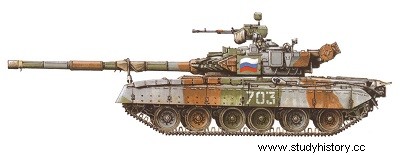
Crew :3 men.
Weight :48,500 t.
Engine :750 hp diesel
Dimensions :
length (body), 7 m;
width , 3.50m;
height , 2.30 m.
Performance
maximum road speed , 70 km/h
range , 450 km
slope , 60%;
vertical obstacle , 0.92 m;
clean cut , 2.80 m.
The layout of the T-80 is conventional:the driver's compartment is at the front, the turret in the center, the engine and transmissions at the rear. A V-shaped ledge is attached to the front glacis of the tank to prevent water from reaching the driver's hatch when fording rivers. It also has a periscope allowing it to drive without exposing itself when the tank is engaged in combat. The tank commander and the gunner take place in the center, on each side of the main armament, which is fed automatically. As a result, the crew is only three, as are those of the older T-64 and T-72.
It is generally accepted that the main armament is a further development of the 125mm gun mounted on the T-64 and T-72. It is unlikely, in fact, that the Soviets will now introduce a new caliber of gun into their tank fleet, since they already have, not to mention the 76 mm of the light amphibious tank PT-76 and the 122 mm of the heavy tank T- 10, three different calibers, namely:the 100 mm of the T-54 and T-55, the 115 mm of the T-62 and the 125 mm of the T-64 and T-72. It is more likely that improvements have been made to ammunition; reports have indeed indicated that these included a uranium-penetrating HVAPFSDS (high-velocity armour-piercing shell), capable of piercing very elaborate armour. The gun is fully stabilized, and the sighting system probably features a laser rangefinder, which had already been added to the later productions of the T-72. A 7.62 mm machine gun is twinned with the main armament, and a 12.7 mm (or 14.5 mm) machine gun will be placed on the roof of the turret, for anti-aircraft defense. The usefulness of the latter is not obvious, considering that the chances of hitting a jet plane are very low. Located on each side of the turret and pointing forward, a battery of four launchers. Since all Soviet tanks have the ability to deploy their own smoke screen by injecting diesel fuel into the exhaust pipe, Western specialists assume that these pot-launchers (identical equipment was observed on the most recent productions of the T-72) release, in fact, decoys capable of deceiving the ATGWs of NATO (the MILAN and the HOT).
The suspension of the T-80 would be of the hydropneumatic type and would allow to adapt the height of the ground clearance according to the terrain crossed. The undercarriage consists of six small road wheels, with the idler wheel at the front and the sprocket at the rear. The upper part of the track and the support rollers are covered with skirts. Common Soviet main battle tanks are equipped with an infrared night vision system, which will be replaced on the T-80 by a passive system. The standard equipment of the latter includes NBC protection and a snorkel allowing the tank to pass rivers with a maximum depth of 5.50 m, greater than the average depth of European rivers.
